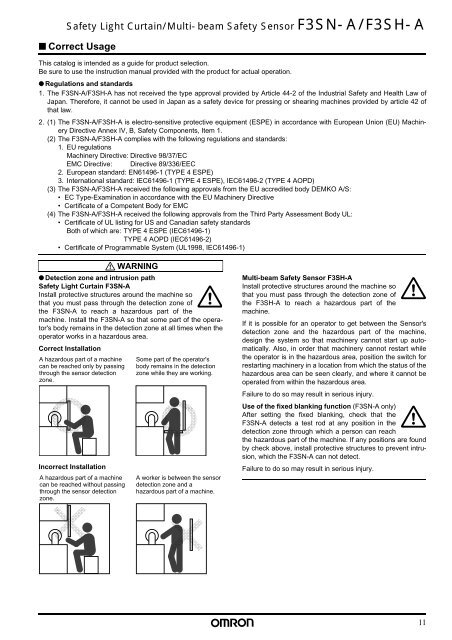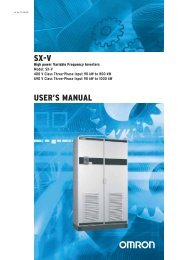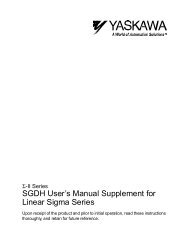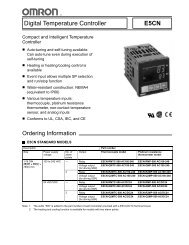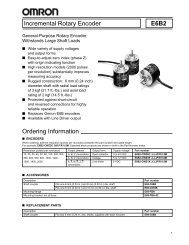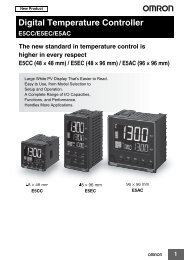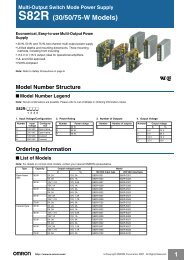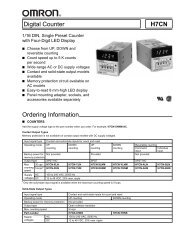Safety Light Curtain / Multi-beam Safety Sensor F3SN-A ... - Omron
Safety Light Curtain / Multi-beam Safety Sensor F3SN-A ... - Omron
Safety Light Curtain / Multi-beam Safety Sensor F3SN-A ... - Omron
You also want an ePaper? Increase the reach of your titles
YUMPU automatically turns print PDFs into web optimized ePapers that Google loves.
<strong>Safety</strong> <strong>Light</strong> <strong>Curtain</strong>/<strong>Multi</strong>-<strong>beam</strong> <strong>Safety</strong> <strong>Sensor</strong> <strong>F3SN</strong>-A/F3SH-A<br />
■ Correct Usage<br />
This catalog is intended as a guide for product selection.<br />
Be sure to use the instruction manual provided with the product for actual operation.<br />
● Regulations and standards<br />
1. The <strong>F3SN</strong>-A/F3SH-A has not received the type approval provided by Article 44-2 of the Industrial <strong>Safety</strong> and Health Law of<br />
Japan. Therefore, it cannot be used in Japan as a safety device for pressing or shearing machines provided by article 42 of<br />
that law.<br />
2. (1) The <strong>F3SN</strong>-A/F3SH-A is electro-sensitive protective equipment (ESPE) in accordance with European Union (EU) Machinery<br />
Directive Annex IV, B, <strong>Safety</strong> Components, Item 1.<br />
(2) The <strong>F3SN</strong>-A/F3SH-A complies with the following regulations and standards:<br />
1. EU regulations<br />
Machinery Directive: Directive 98/37/EC<br />
EMC Directive: Directive 89/336/EEC<br />
2. European standard: EN61496-1 (TYPE 4 ESPE)<br />
3. International standard: IEC61496-1 (TYPE 4 ESPE), IEC61496-2 (TYPE 4 AOPD)<br />
(3) The <strong>F3SN</strong>-A/F3SH-A received the following approvals from the EU accredited body DEMKO A/S:<br />
• EC Type-Examination in accordance with the EU Machinery Directive<br />
• Certificate of a Competent Body for EMC<br />
(4) The <strong>F3SN</strong>-A/F3SH-A received the following approvals from the Third Party Assessment Body UL:<br />
• Certificate of UL listing for US and Canadian safety standards<br />
Both of which are: TYPE 4 ESPE (IEC61496-1)<br />
TYPE 4 AOPD (IEC61496-2)<br />
• Certificate of Programmable System (UL1998, IEC61496-1)<br />
● Detection zone and intrusion path<br />
<strong>Safety</strong> <strong>Light</strong> <strong>Curtain</strong> <strong>F3SN</strong>-A<br />
Install protective structures around the machine so<br />
that you must pass through the detection zone of<br />
the <strong>F3SN</strong>-A to reach a hazardous part of the<br />
machine. Install the <strong>F3SN</strong>-A so that some part of the operator's<br />
body remains in the detection zone at all times when the<br />
operator works in a hazardous area.<br />
Correct Installation<br />
A hazardous part of a machine<br />
can be reached only by passing<br />
through the sensor detection<br />
zone.<br />
Incorrect Installation<br />
A hazardous part of a machine<br />
can be reached without passing<br />
through the sensor detection<br />
zone.<br />
WARNING<br />
Some part of the operator's<br />
body remains in the detection<br />
zone while they are working.<br />
A worker is between the sensor<br />
detection zone and a<br />
hazardous part of a machine.<br />
<strong>Multi</strong>-<strong>beam</strong> <strong>Safety</strong> <strong>Sensor</strong> F3SH-A<br />
Install protective structures around the machine so<br />
that you must pass through the detection zone of<br />
the F3SH-A to reach a hazardous part of the<br />
machine.<br />
If it is possible for an operator to get between the <strong>Sensor</strong>'s<br />
detection zone and the hazardous part of the machine,<br />
design the system so that machinery cannot start up automatically.<br />
Also, in order that machinery cannot restart while<br />
the operator is in the hazardous area, position the switch for<br />
restarting machinery in a location from which the status of the<br />
hazardous area can be seen clearly, and where it cannot be<br />
operated from within the hazardous area.<br />
Failure to do so may result in serious injury.<br />
Use of the fixed blanking function (<strong>F3SN</strong>-A only)<br />
After setting the fixed blanking, check that the<br />
<strong>F3SN</strong>-A detects a test rod at any position in the<br />
detection zone through which a person can reach<br />
the hazardous part of the machine. If any positions are found<br />
by check above, install protective structures to prevent intrusion,<br />
which the <strong>F3SN</strong>-A can not detect.<br />
Failure to do so may result in serious injury.<br />
11


